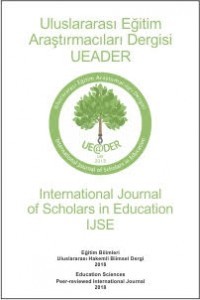Dialogic or Authoritative Talk: Which one is more Comprehensible?
Dialogic or Authoritative Talk: Which one is more Comprehensible?
The present study sought to explore whether a text supported primarily with dialogic talk is more comprehensible than a text supported with an authoritative one. A phenomenological case study approach was utilized in gathering and analyzing the data. The students’ lived experiences with dialogic and authoritative talks were our focus of concern. A total of 14 college students participated in the study. Individual interviews were conducted, recorded, and transcribed. The transcriptions were later analyzed inductively to discover patterns in the data. The results indicated that dialogic talk was found comprehensible by all participating students without any exception. The authoritative talk, on the other hand, was found incomprehensible. According to the students, the dialogic talk is easy to understand because it is written in a step-by-step fashion, comprises daily life words or recognizable with ease, is about a hands-on activity, and is student inclusive. They, further, indicated that the authoritative talk was incomprehensible because it involves technical terms, is superficially written, does not involve experimentation, and does not encourage students to take part.
___
- Bakhtin, M. M. (1981). The dialogic imagination: Four essays by M. M. Bakhtin. University of Texas Press.
- Bakhtin, M. (1986). The problem of speech genres. In Speech genres and other late essays (pp. 60-102). University of Texas Press.
- Dawes, L., Mercer, N., & Wegerif, R. (2000). Thinking together: Activities for teachers and children at key stage 2. Questions Publishing Co.
- EEF. (July 2011). Dialogic teaching, education endowment foundation (EEF). https://educationendowmentfoundation.org.uk/ Forman, E. A., McCormick, D. E., & Donato, R. (1998). Learning what counts as a mathematical explanation, 9(4), 313-339.
- Lyle, S. (2008). Dialogic teaching: discussing theoretical contexts and reviewing evidence from classroom practice. Language and Education, 22(3), 222-240.
- Mercer, N., Hennessy, S., & Warwick, P. (2019). Dialogue, thinking together and digital technology in the classroom. Some educational implications of a continuing line of inquiry. International Journal of Educational Research, 97, 187-199.
- Miles, M. B., & Huberman, A. M. (1994). Qualitative data analysis: An expanded sourcebook. Sage Publications.
- Molinari, L., & Mameli, C. (2010). Classroom dialogic discourse: An observational study. Procedia Social and Behavioral Sciences, (2), 3857–3860.
- Patton, M. Q. (2002). Variety in qualitative inquiry: Theoretical orientations. In C. DD. Laughton V. Novak, D. E. Axelsen, K. Journey & K. Peterson (Eds.), Qualitative research & evaluation methods (pp. 75–138). Sage Publications.
- Saglam, Y., & Kanadli, S. (2021). Nitel veri analizinde kodlama [Coding in qualitative data analysis]. Pegem Akademi
- Vygotsky, L. S. (1929). The Problem of the cultural development of the child. Journal of Genetic Psychology, 36, 415-434.
- Vygotsky, L. S. (1930). Mind and society. Harvard University Press.
- Vygotsky, L. S. (1978). Mind in society: The development of higher psychological processes. Harvard University Press.
- Vygotsky, L. S. (1981). The genesis of higher mental functions. In J. V. Wertsch (Ed.), The concept of activity in soviet psychology (pp. 144-188). M.E. Sharpe. Wertsch, J. V. (1991). Voices of the mind: A sociocultural approach to mediated action. Harvard University Press.
- Başlangıç: 2018
- Yayıncı: Durmuş BURAK
Sayıdaki Diğer Makaleler
Dialogic or Authoritative Talk: Which one is more Comprehensible?
Analysing the Effect of Coding-Based Applications on Retention Scores through the Mixed-Meta Method
Öğretmen Adaylarının “Fen Eğitimi” Kavramına Yönelik Yaratıcı Karşılaştırmalarının İncelenmesi
Zeynel Abidin YILMAZ, Mehmet Diyaddin YAŞAR
Meta-Thematic Analysis of Constructivist Approach in the Second Level of Primary Education
Nazan YALÇIN, Derya TATLI, Büşra Burçak ÇAKAR, Zehra KAYA
